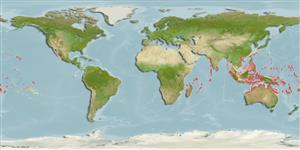Common names from other countries
分类 / Names
俗名 | 同种异名 | Catalog of Fishes(属, 种) | ITIS | CoL | WoRMS | Cloffa
Environment: milieu / climate zone / depth range / distribution range
生态学
海洋 礁区鱼类; 深度上下限 1 - 15 m (Ref. 86942). 熱帶; 32°N - 24°S
Indo-Pacific: East Africa to the Tuamoto Islands, north to southern Japan and the Ogasawara Islands, south to the Great Barrier Reef.
印度-太平洋: 東非到 Tuamoto 島, 北至日本南部與小笠原群島, 南至大堡礁。
大小 / 重量 / 年龄
Maturity: Lm ? range ? - ? cm
Max length : 5.0 cm TL 雄鱼/尚未辨别雌雄; (Ref. 2334)
背棘 (总数) : 7 - 8; 背的软条 (总数) : 12 - 13; 臀棘: 2; 臀鳍软条: 11 - 12. Uniformly dark species that has smaller, but longer tubercles than C. maculatus and lacks a notch in the dorsal fin.
全黑色种具有较小的, 但是较长的小瘤超过 C. maculatus 而且在背鳍中缺乏一个凹槽。
Facultative air-breathing (Ref. 126274); Found among branches of Stylophora mordax and certain Acropora corals (Ref. 9710). It never ventures outside the confines of the coral head where it swims between the branches foraging for other coral-dwelling types (Ref. 275). Anterolateral glandular groove with venom gland; at least in dorsal-fin spines (Ref. 57406).
发现于 Stylophora mordax 与特定的 Acropora 珊瑚的分支中了。 (参考文献 9710) 它从不冒险外出至珊瑚顶部的疆界在那里它在珊瑚枝之间游动觅食其他的栖息于珊瑚的类型.(参考文献 275) 用毒液腺的前外侧的腺凹槽; 至少在背鳍棘。 (参考文献 57406)
Life cycle and mating behavior
Maturities | 繁殖 | Spawnings | Egg(s) | Fecundities | 仔鱼
印度-太平洋: 東非到 Tuamoto 島, 北至日本南部與小笠原群島, 南至大堡礁。
Paxton, J.R., D.F. Hoese, G.R. Allen and J.E. Hanley, 1989. Pisces. Petromyzontidae to Carangidae. Zoological Catalogue of Australia, Vol. 7. Australian Government Publishing Service, Canberra, 665 p. (Ref. 7300)
CITES (Ref. 128078)
Not Evaluated
人类利用
工具
特别资料
下载 XML
网络资源
Estimates based on models
Preferred temperature (Ref.
115969): 25.4 - 29.3, mean 28.3 (based on 2461 cells).
Phylogenetic diversity index (Ref.
82804): PD
50 = 0.5625 [Uniqueness, from 0.5 = low to 2.0 = high].
Bayesian length-weight: a=0.01995 (0.00906 - 0.04395), b=3.01 (2.83 - 3.19), in cm Total Length, based on all LWR estimates for this body shape (Ref.
93245).
营养阶层 (Ref.
69278): 3.6 ±0.59 se; based on food items.
Fishing Vulnerability (Ref.
59153): Low vulnerability (10 of 100).
